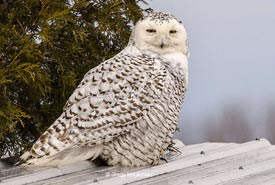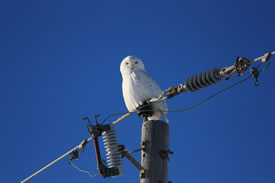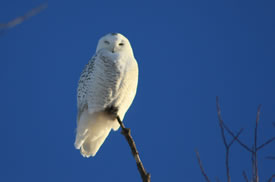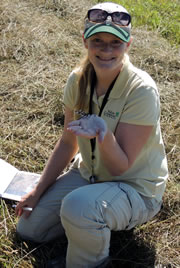A Canadian winter warrior

Snowy owl (Photo by Gregg McLachlan)
A few winters back, during the continued irruption of snowy owls into southern Ontario, I was lucky enough to come across a “snowy hot spot” just 25 minutes from my home in Guelph, Ontario. My husband and I have passed many Sundays cruising around the windswept roads of an agricultural area that resembles Arctic tundra for all its vast open spaces, strong cold winds and dim winter sunshine. Twice we have been lucky enough to spot five snowy owls in one day (five seems to be the magic number!). Sometimes they’re huddled on the ground, doing their best “clump of snow” impression. Sometimes perched wisely on a hydro pole listening and watching for mice. Sometimes in flight across a wide field choosing a new vantage point. We delight in the males that are nearly pure white but always enjoy a glimpse of the large gray/white females too, who seem to be a bit braver. Anytime winter days are tough (there have been a few of those lately!), a trip to snowy owl country is sure to add a bit of excitement to a winter day. Below is a memory of one of the times spent in snowy owl country:
There was one winter where it felt like everybody I knew got to see a snowy owl, except me. I remember my little niece explaining to me one Christmas, “Aunt Kristyn, we saw this big, white owl!” and instead of feeling happy for her, I was intensely jealous!

This snowy encounter was a long time coming, and it made my day. (Photo by NCC)
But then in January 2015, I had my moment — it was actually five moments in a row, spread out over one incredible afternoon near the Minesing Wetlands in Ontario. I was lucky enough to spend a beautiful winter day gazing at five separate snowy owls. I burst into the meeting I was due at that afternoon, freezing cold, 10 minutes late and vibrating with excitement, showing my colleagues the 300 pictures I had taken (I wish that was an exaggeration; they likely do as well).
My love affair with these owls has continued in earnest ever since and doesn’t show any sign of letting up.
I just love the way it feels when I lock eyes with this incredible creature — my green to its yellow. I find myself wondering about where it’s been, what winter here in southern Ontario must be like for it, and what life looks like for this particular snowy owl during the summer months on the Arctic tundra, when daylight is long and lemmings, a snowy owl's favourite food source, are plentiful.

Although this snowy owl seemed unperturbed by my presence, it's best to keep a fair distance between the owl and yourself. (Photo by NCC)
I find the pictures from the summer breeding grounds of snowy owls, in which their nests are literally lined with heaps of dead lemmings, just hilarious. I picture the owls having the most fabulous feasts, producing record numbers of chicks, and dining and having a “hoot” with their fellow feathered friends about how good the eats are. It’s these super productive summers that send a lot of owls deeper south to Canada and in bigger numbers than usual, and I’ve heard rumours that this winter may be another year where we can expect higher than usual numbers of snowy owls. This is so exciting, and I will certainly be on the lookout at this year’s Guelph Christmas Bird Count and during long drives across Ontario.
The Bird Count also brings up an important point that must be always kept at the forefront: we need to take care to always view these owls from a distance, noting their body language and behaviour and knowing when it’s time to move on.
Though the long, cold, dark days of winter can bring some serious snow shovelling, damp and chilly feet, and those dreaded winter blues, it always helps me to think about the incredible things that can blow in from the Arctic on the back of winter winds, including the majestic, mysterious and always compelling snowy owl.
The snowy owl is one of 30 species and habitats featured in NCC’s gift giving campaign: Gifts of Canadian Nature. To learn more and to give the gift of conservation this holiday season, click here.


